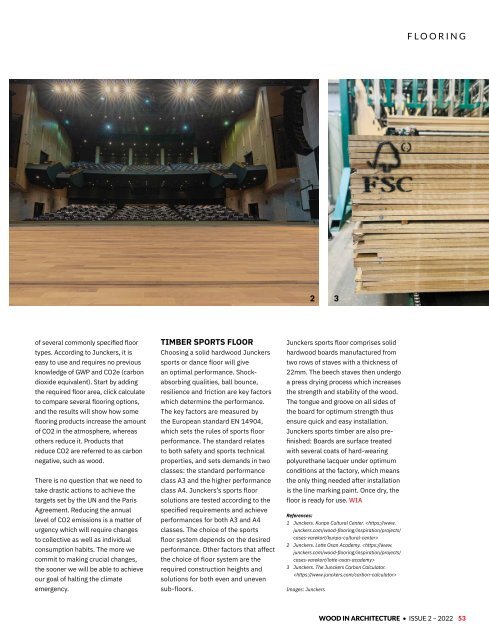Wood In Architecture Issue 2, 2022
First published in 2017, Wood in Architecture (WIA) is a bi-annual trade magazine devoted to the international timber construction sector. The newest addition to the Panels & Furniture Group of wood magazines, WIA features in-depth insights to the latest industry news, incredible projects and leading trade events. WIA is an advocate for timber as a material of choice for today’s built environment, and is the perfect source of inspiration for architects, builders, engineers and interior designers across the globe.
First published in 2017, Wood in Architecture (WIA) is a bi-annual trade magazine devoted to the international timber construction sector. The newest addition to the Panels & Furniture Group of wood magazines, WIA features in-depth insights to the latest industry news, incredible projects and leading trade events. WIA is an advocate for timber as a material of choice for today’s built environment, and is the perfect source of inspiration for architects, builders, engineers and interior designers across the globe.
You also want an ePaper? Increase the reach of your titles
YUMPU automatically turns print PDFs into web optimized ePapers that Google loves.
FLOORING<br />
2 3<br />
of several commonly specified floor<br />
types. According to Junckers, it is<br />
easy to use and requires no previous<br />
knowledge of GWP and CO2e (carbon<br />
dioxide equivalent). Start by adding<br />
the required floor area, click calculate<br />
to compare several flooring options,<br />
and the results will show how some<br />
flooring products increase the amount<br />
of CO2 in the atmosphere, whereas<br />
others reduce it. Products that<br />
reduce CO2 are referred to as carbon<br />
negative, such as wood.<br />
There is no question that we need to<br />
take drastic actions to achieve the<br />
targets set by the UN and the Paris<br />
Agreement. Reducing the annual<br />
level of CO2 emissions is a matter of<br />
urgency which will require changes<br />
to collective as well as individual<br />
consumption habits. The more we<br />
commit to making crucial changes,<br />
the sooner we will be able to achieve<br />
our goal of halting the climate<br />
emergency.<br />
TIMBER SPORTS FLOOR<br />
Choosing a solid hardwood Junckers<br />
sports or dance floor will give<br />
an optimal performance. Shockabsorbing<br />
qualities, ball bounce,<br />
resilience and friction are key factors<br />
which determine the performance.<br />
The key factors are measured by<br />
the European standard EN 14904,<br />
which sets the rules of sports floor<br />
performance. The standard relates<br />
to both safety and sports technical<br />
properties, and sets demands in two<br />
classes: the standard performance<br />
class A3 and the higher performance<br />
class A4. Junckers’s sports floor<br />
solutions are tested according to the<br />
specified requirements and achieve<br />
performances for both A3 and A4<br />
classes. The choice of the sports<br />
floor system depends on the desired<br />
performance. Other factors that affect<br />
the choice of floor system are the<br />
required construction heights and<br />
solutions for both even and uneven<br />
sub-floors.<br />
Junckers sports floor comprises solid<br />
hardwood boards manufactured from<br />
two rows of staves with a thickness of<br />
22mm. The beech staves then undergo<br />
a press drying process which increases<br />
the strength and stability of the wood.<br />
The tongue and groove on all sides of<br />
the board for optimum strength thus<br />
ensure quick and easy installation.<br />
Junckers sports timber are also prefinished:<br />
Boards are surface treated<br />
with several coats of hard-wearing<br />
polyurethane lacquer under optimum<br />
conditions at the factory, which means<br />
the only thing needed after installation<br />
is the line marking paint. Once dry, the<br />
floor is ready for use. WIA<br />
References:<br />
1 Junckers. Kunpo Cultural Center. <br />
2 Junckers. Lotte Osan Academy. <br />
3 Junckers. The Junckers Carbon Calculator.<br />
<br />
Images: Junckers<br />
WOOD IN ARCHITECTURE • ISSUE 2 – <strong>2022</strong> 53


















